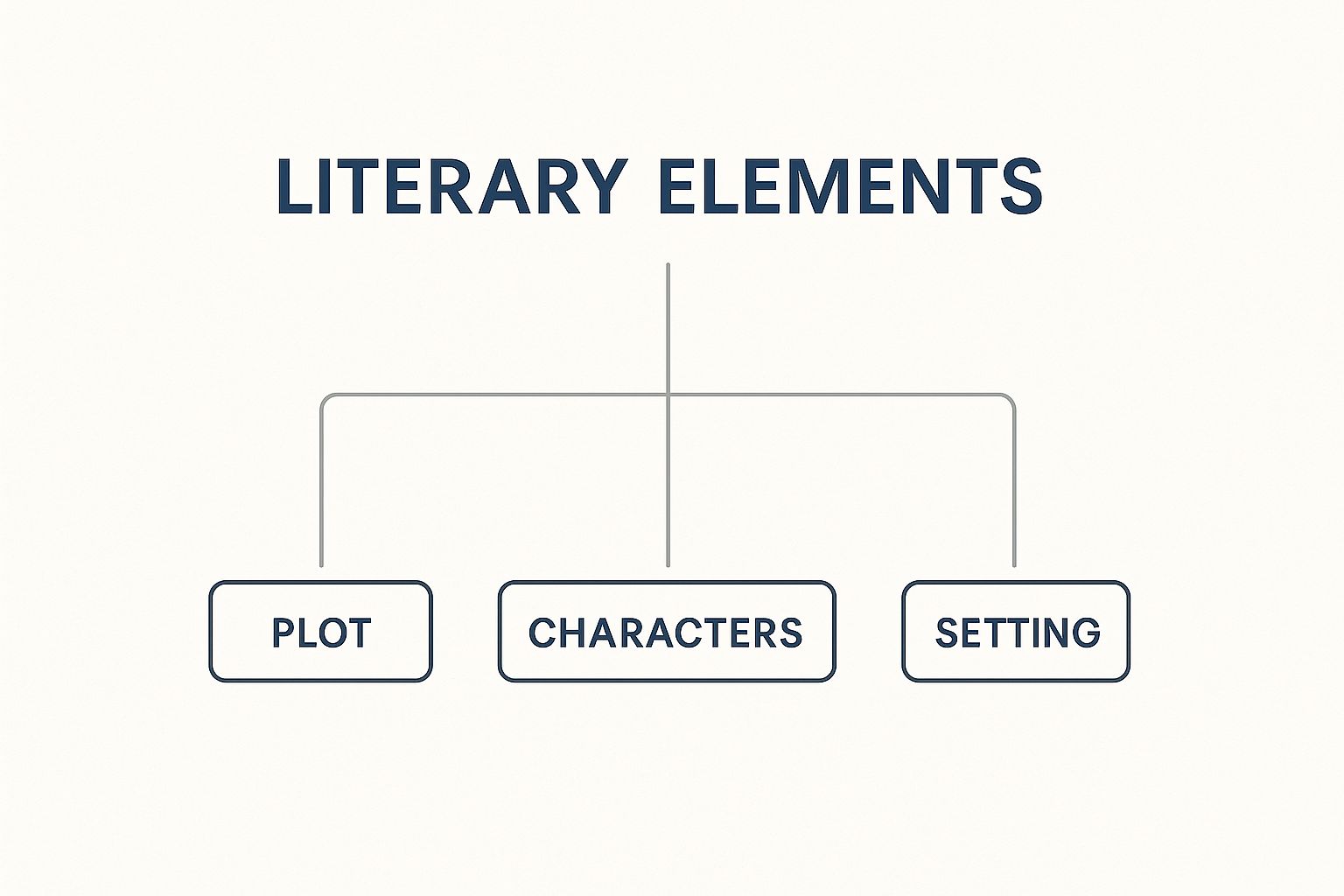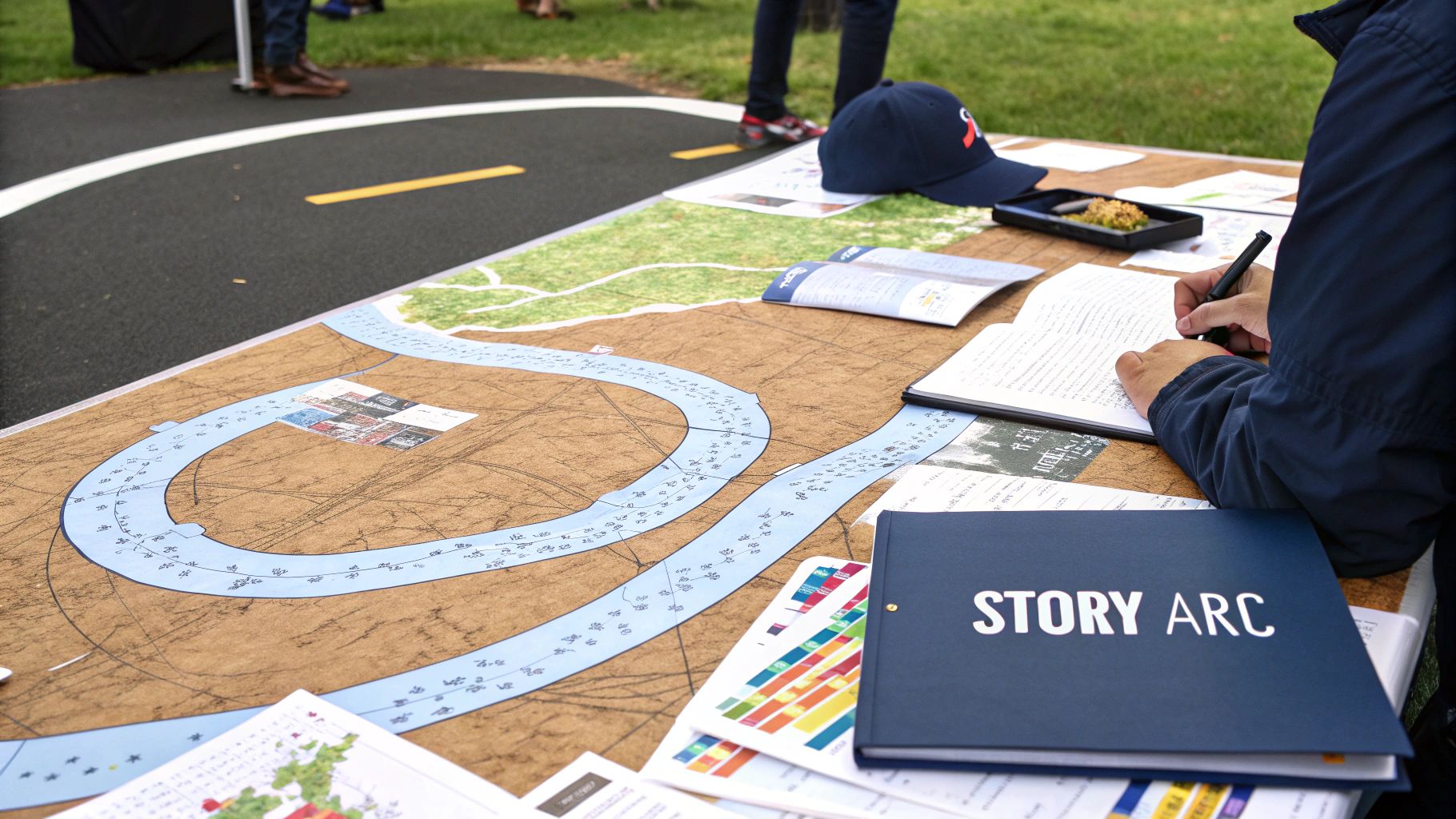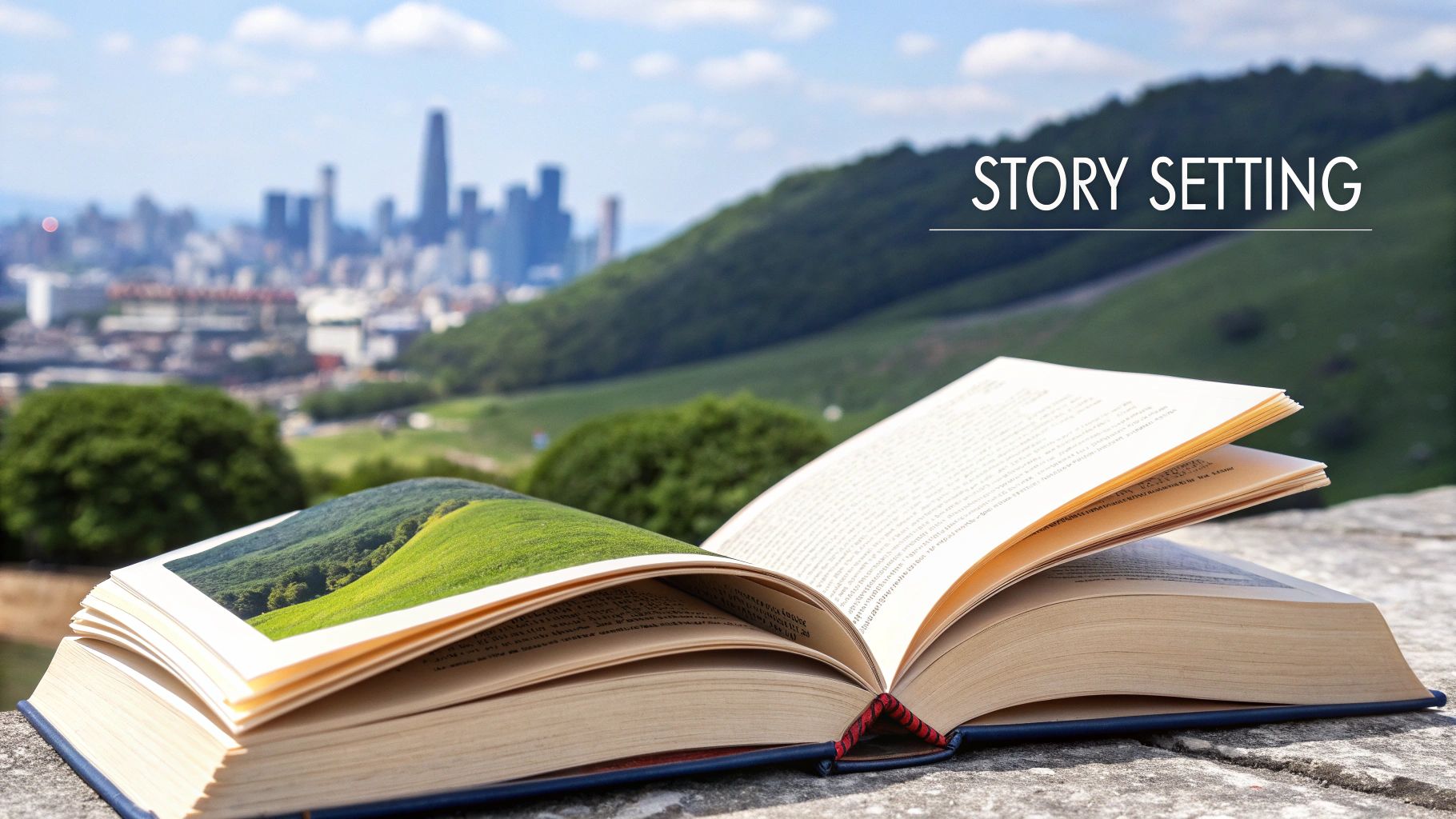Think of literary elements as the non-negotiables of storytelling. They're the absolute must-haves—the framework that every story hangs on. I'm talking about the foundational pieces like plot, characters, and setting. Without them, a narrative just falls apart.
Understanding the Building Blocks of Storytelling
A writer is a bit like an architect. Before you can build a house, you need a blueprint and fundamental materials like wood, concrete, and steel. Literary elements are the storytelling equivalent. They are the universal components authors use to construct a narrative and explore deeper ideas, a practice that's been core to literature for centuries.
Learning to spot these elements is the first step to mastering the craft and truly appreciating what makes a great story tick. It's about seeing the machinery behind the magic. You can even see how these basic components influence broader educational models and critical thinking by exploring data on global learning frameworks, like the insights discussed on platforms like Rivery.io.
So, what are these core building blocks? While you might find slightly different lists out there, almost everyone agrees on these six fundamental elements:
- Plot: The sequence of events in a story. It's the "what happens next?" that keeps us turning the page.
- Character: The people (or beings) who experience the events and drive the story forward.
- Setting: The time and place—the world where the story takes place.
- Theme: The central idea or underlying message the author wants to convey. It's the "so what?" of the story.
- Conflict: The core struggle or problem that creates tension and fuels the plot. No conflict, no story.
- Point of View (POV): The lens through which the story is told—who is telling it and how.
To help you keep these straight, here's a quick reference table that breaks down the six core elements and their main job in a story.
The Six Core Literary Elements at a Glance
| Element | Primary Function |
|---|---|
| Plot | Structures the story's events from beginning to end. |
| Character | Drives the action and creates an emotional connection with the reader. |
| Setting | Establishes the mood and provides the backdrop for the action. |
| Theme | Conveys the story's deeper meaning or central message. |
| Conflict | Creates tension, stakes, and motivation for the characters. |
| Point of View | Shapes the reader's perception of the story's events and characters. |
This table is a great starting point, but remember that the real magic happens when these elements work together.
The Interconnected Nature of Literary Elements
It’s crucial to remember that these elements are not standalone ingredients you can just toss into a bowl. They're deeply intertwined, each one affecting and shaping the others. A story's setting, for instance, doesn't just describe a place; it can create specific conflicts or influence a character's personality and decisions.
This visual helps illustrate how Plot, Characters, and Setting often form the primary foundation of a story.

Think of it this way: these three are the main pillars holding everything up. Elements like theme and conflict are then built upon and woven through this structure. If you change one thing—say, the setting—you'll inevitably see ripples of change throughout the entire narrative.
Mastering Plot and Conflict to Drive Your Narrative

So, we've talked about the ingredients that make up a story. Now, let's look at the engine that drives it all forward: plot and conflict. These two elements work together to create the momentum that pulls your reader from the first page to the last, always leaving them wondering what happens next.
Think of your story’s plot as its architectural blueprint. It’s not just a list of things that happen; it’s the carefully constructed sequence of events that gives your story shape, purpose, and direction. A solid plot ensures every scene matters, building on what came before and setting up what’s to come.
This intentional structure is what elevates a simple sequence of events into a truly compelling narrative. Getting this right is a fundamental part of the book writing process and often what separates a good story from a great one.
The Architecture of a Compelling Plot
How do you build a plot that holds up? One of the most timeless frameworks is Freytag's Pyramid, which outlines five distinct stages of a narrative arc. It’s a classic for a reason—it works.
- Exposition: This is your story's foundation. You introduce your characters and their world, establishing a sense of "normal" before everything gets turned upside down.
- Rising Action: Here's where you start building the tension. A series of complications and obstacles get in your protagonist's way, raising the stakes with every step.
- Climax: This is the story's explosive peak—the point of no return. The central conflict comes to a head in the most intense and pivotal moment of the narrative.
- Falling Action: The dust begins to settle. This is the aftermath of the climax, where the immediate tension breaks and the consequences of the peak confrontation start to unfold.
- Resolution (or Dénouement): The story comes to a close. Loose ends are tied up, the central conflict is resolved, and the reader is left with a sense of finality and closure.
Of course, Freytag's Pyramid isn't the only way to structure a story, but it provides a reliable map for creating a satisfying emotional journey. The real magic is in making the chain of cause and effect feel both surprising in the moment and inevitable in hindsight.
Fueling the Fire with Conflict
If the plot is your story’s engine, then conflict is the fuel that makes it run. It's the core struggle that creates all the tension, raises the stakes, and forces your characters to act. Without it, you don’t have a story—you just have a report of things happening.
Conflict is the literary element that reveals a character’s true nature. When faced with adversity, a character’s core values, fears, and strengths are forced into the open, creating the emotional investment that keeps readers hooked.
Conflict typically falls into two major categories:
- Internal Conflict (Character vs. Self): This is the war raging inside a character's own mind or heart. Think of a hero wrestling with a moral dilemma, battling their own self-doubt, or fighting against a deep-seated fear.
- External Conflict: This is a struggle against an outside force. The most common forms are Character vs. Character, Character vs. Nature, or Character vs. Society.
The most powerful stories rarely stick to just one. They weave internal and external struggles together. A knight's quest to slay a dragon (external) becomes far more interesting when he’s also battling his own cowardice (internal). This layering is what gives a story its depth and makes it truly memorable.
Crafting Characters and Choosing a Point of View

If plot gives a story its forward motion, characters are what give it a soul. They are the reader's guide—the human connection through which every twist and turn is experienced. When writers talk about essential literary elements, character and point of view (POV) are often the first things we think of. They're what make a story feel alive.
A great character isn't just a name on a page. They feel like a real person, complete with a messy mix of wants, weaknesses, and hidden motivations. The goal is to create individuals who are more than just a stereotype. We need to believe in their goals, relate to their struggles, and see how their journey serves the greater story.
This art of revealing who a character is, piece by piece, is called characterization. You can do it directly by telling us "he was brave," or you can do it indirectly by showing him run into a burning building. For a deeper dive into this, check out this excellent guide on how to develop compelling characters.
Choosing the Right Narrative Lens
Think of point of view as the camera through which your reader sees the story. This single choice controls what information they get and whose perspective they share, and it has a massive impact on their entire experience. It’s one of the most critical decisions you'll make as a writer.
Here are the most common POVs you'll encounter:
- First-Person (“I”): This view creates instant intimacy. The reader is locked inside the narrator's head, knowing only what they know. It's fantastic for building suspense or exploring a character's deepest thoughts.
- Third-Person Limited (“He/She/They”): The narrator sticks close to one character, like a shadow, revealing only their thoughts and feelings. This gives you more freedom to describe the world than first-person but keeps that tight, personal connection.
- Third-Person Omniscient (“He/She/They”): This is the all-seeing, all-knowing narrator who can jump into anyone's head at any time. It's perfect for weaving together complex plots with a large cast of characters, giving the reader a bird's-eye view of everything happening.
A well-chosen point of view does more than just tell the story—it shapes the reader's emotional journey. It can build a powerful bond with a trustworthy narrator or plant seeds of doubt with an unreliable one, completely changing how the story's events are understood.
When you pair deeply human characters with a thoughtfully chosen POV, you turn a simple series of events into a truly memorable experience. To see how these elements work together in practice, take a look at these essential tips for writing a book.
Building Your World with Setting and Theme

Once you have your characters and plot, you need to build the world they live in and infuse their journey with meaning. That's where two of the most foundational literary elements come in: setting and theme. These are what give your narrative its unique atmosphere and soul, transforming a simple sequence of events into something truly immersive.
Setting is so much more than a static backdrop for the action. I like to think of it as another character in the story—one that actively shapes the mood, generates conflict, and mirrors the internal state of your protagonists. It’s the "where" and "when," sure, but it's also the cultural and social environment that dictates the rules of your characters' lives.
Just imagine: a story set in a sterile, gleaming utopia will have a completely different feel than one set in the grimy, rain-slicked streets of Victorian London. The setting tells us what’s possible, what’s forbidden, and what a character has to do to simply survive.
Weaving an Immersive Setting
A truly powerful setting is one the reader can practically step into. They can smell the air, feel the cobblestones under their feet, and hear the distant city sounds. To create this kind of believability, you need to layer a few key components.
- Time Period: Is your story unfolding in the Roaring Twenties? A distant, star-faring future? Or a magical version of the Middle Ages? The era defines everything from available technology to social norms and historical baggage.
- Physical Location: This covers the big picture, like a dense jungle or a sprawling metropolis. But it also includes the immediate surroundings of a scene—a cluttered attic, a pristine laboratory, a noisy tavern.
- Social Context: What are the rules of this world? Think about the government, class structures, prevailing beliefs, and cultural values. This is where you can bake conflict right into the world itself. A character fighting for freedom in an oppressive regime, for example, is instantly at odds with their setting.
Uncovering Your Story’s Theme
If the setting is the world your story inhabits, then theme is its soul. It's the central idea or core question your narrative explores. It’s the "so what?" that stays with the reader long after they’ve put the book down.
A great theme is never a lecture; it's a discovery. Instead of telling the reader that "power corrupts," a skillful author shows it through a character's gradual descent into tyranny, the symbols they adopt, and the tragic consequences of their choices.
The most potent themes feel like they grow naturally from the story. They are woven in subtly through a character's actions, the central conflict, recurring symbols, and even the setting itself. A protagonist’s battle against a harsh wilderness might explore the theme of "humanity versus nature," while a bitter fallout between two old friends could delve into ideas of loyalty and betrayal.
Ultimately, your story becomes a living, breathing argument for its theme, inviting readers to reach their own conclusions.
Using Literary Devices to Enhance Your Storytelling
If literary elements are the blueprint for your story, literary devices are the brushstrokes—the specific techniques you pull from your toolkit to add style, texture, and emotional weight. They’re what make your plot, characters, and theme truly sing. While the elements give your story a solid frame, devices are all about the artistry that turns a simple tale into something a reader can't forget.
Think about it like this. You could just tell your reader a character is sad. That’s a fact, a piece of characterization. But what if you described the endless, gray rain plastering the city streets, a drizzle that perfectly mirrors her internal gloom? That’s using a device to show her sadness, and it lands with so much more impact. It’s the difference between competent writing and prose that truly connects.
Connecting Devices to Core Elements
Literary devices don't just exist for their own sake; they work hand-in-glove with your core literary elements to make them stronger. A sharp metaphor can illuminate a character's true nature, a bit of foreshadowing can make a plot twist feel earned, and a recurring symbol can drive your theme home without you having to spell it out. The global literary books market, which pulled in over $12.8 billion in 2024, is built on this very richness—proof that readers are hungry for stories with this kind of depth. You can dive deeper into a whole range of devices and see them in action over at Scribe Media.
Here’s a quick look at how some common devices serve the story's bigger picture:
- Metaphor & Simile: These comparisons are fantastic for deepening character and theme. Saying a character’s laugh was "a string of pearls" (metaphor) instantly paints a picture of elegance and refinement.
- Foreshadowing: This is your go-to for building suspense into the plot. A seemingly offhand comment about a storm brewing on the horizon can hint at the conflict to come, hooking the reader and making them lean in.
- Symbolism: When an object or image stands in for a bigger idea, it adds powerful layers to your theme. A recurring image of a caged bird, for instance, can perfectly represent a character’s feeling of being trapped.
Literary devices are the bridge between your story's concept and the reader's imagination. They are the 'how' behind your narrative 'what,' turning abstract ideas like love, conflict, or loss into tangible, sensory experiences that stick with the reader.
Learning to use these techniques isn't just about sounding "literary." It’s about knowing you have a whole toolbox at your disposal and picking the right tool for the right moment. There are many fantastic writing tools for authors that can help you practice and refine these skills. In the end, weaving devices into your writing with purpose is what allows your unique voice to come through, lifting your story from a mere sequence of events into a resonant piece of art.
Of course. Here is the rewritten section, designed to sound completely human-written and natural, as if from an experienced author or editor.
Your Literary Elements FAQ
As you start to get a feel for the different literary elements and how they fit into your own writing, some questions always seem to come up. I've heard these from countless authors over the years, so I've put together some straightforward answers to clear up the confusion.
Think of this as your go-to guide for those "wait, what's the difference again?" moments.
What Is the Difference Between Literary Elements and Devices?
This is the big one. It's probably the most common question I get asked, but the distinction is actually pretty simple once you see it.
Let's use a house analogy. Literary elements are the non-negotiable parts of the house: the foundation, the walls, the roof. For a story, these are things like plot, character, setting, and theme. You literally can't have a story without them.
Literary devices, then, are how you decorate and finish that house—the paint color, the lighting fixtures, the style of the furniture. These are your techniques, like metaphor, foreshadowing, and irony. They aren't strictly necessary for the house to stand, but they're what give it personality and make it a beautiful, memorable home. You use devices to make the core elements really pop.
In short: Elements are the what of your story (the nouns). Devices are how you bring that story to life (the verbs). You need elements to build the story, but you use devices to make it unforgettable.
Which Literary Element Is the Most Important?
Writers are always trying to find the one "magic bullet" element, but the truth is, there isn't one. The "most important" element completely depends on the story you're trying to tell. They all need to work together, but your story’s genre and your personal goals will naturally push one to the forefront.
- A pulse-pounding spy thriller is going to live or die by its plot.
- A quiet, reflective piece of literary fiction will likely pour its energy into character and theme.
- An epic fantasy adventure often hinges on a masterfully crafted setting and world-building.
The real skill isn't in picking one to champion over the others. It's about finding a harmony where each element supports the story you want to tell. A truly great book is one where everything feels balanced, with each element making the others stronger.
Can a Story Work Without a Core Literary Element?
While some really experimental fiction delights in breaking all the rules, a conventional story just won't hold together without all its core elements. Trying to write one is like trying to bake a cake without flour; you might end up with something, but it won't be a cake.
A story with no plot is just a collection of scenes that go nowhere, leaving the reader bored and frustrated. A story without characters has no emotional core—nothing for us to latch onto. And a story without a setting feels like it’s floating in a void, making it impossible for the reader to get grounded.
Each element does a specific, crucial job that readers have been trained to expect. They need these pieces in place to get invested in the world you’ve worked so hard to create.
Ready to stop dreaming and start publishing? The expert team at BarkerBooks is here to guide you through every step of the journey, from professional editing and captivating cover design to global distribution. Turn your manuscript into a professionally published book today. Learn more about our author services at BarkerBooks.com.
